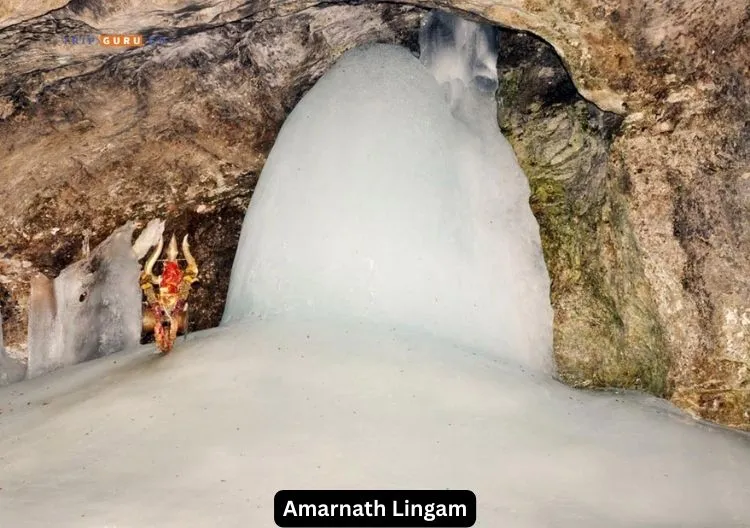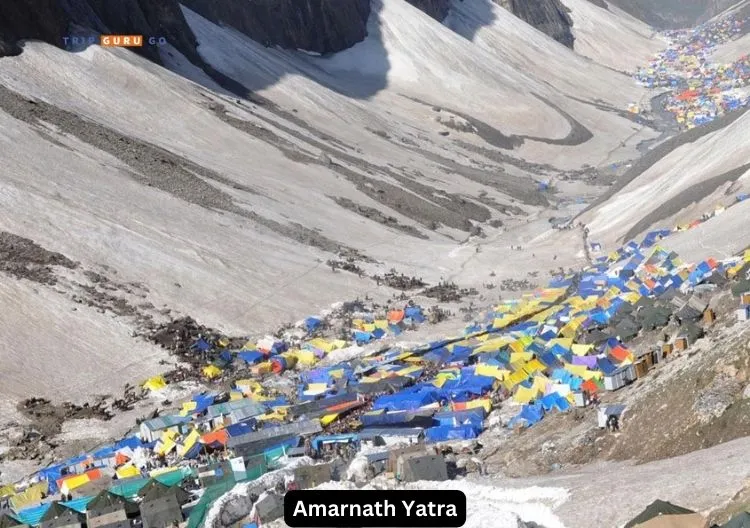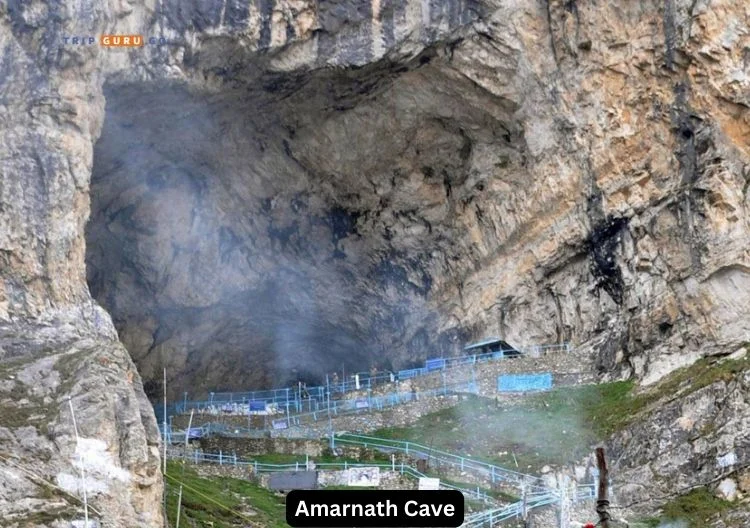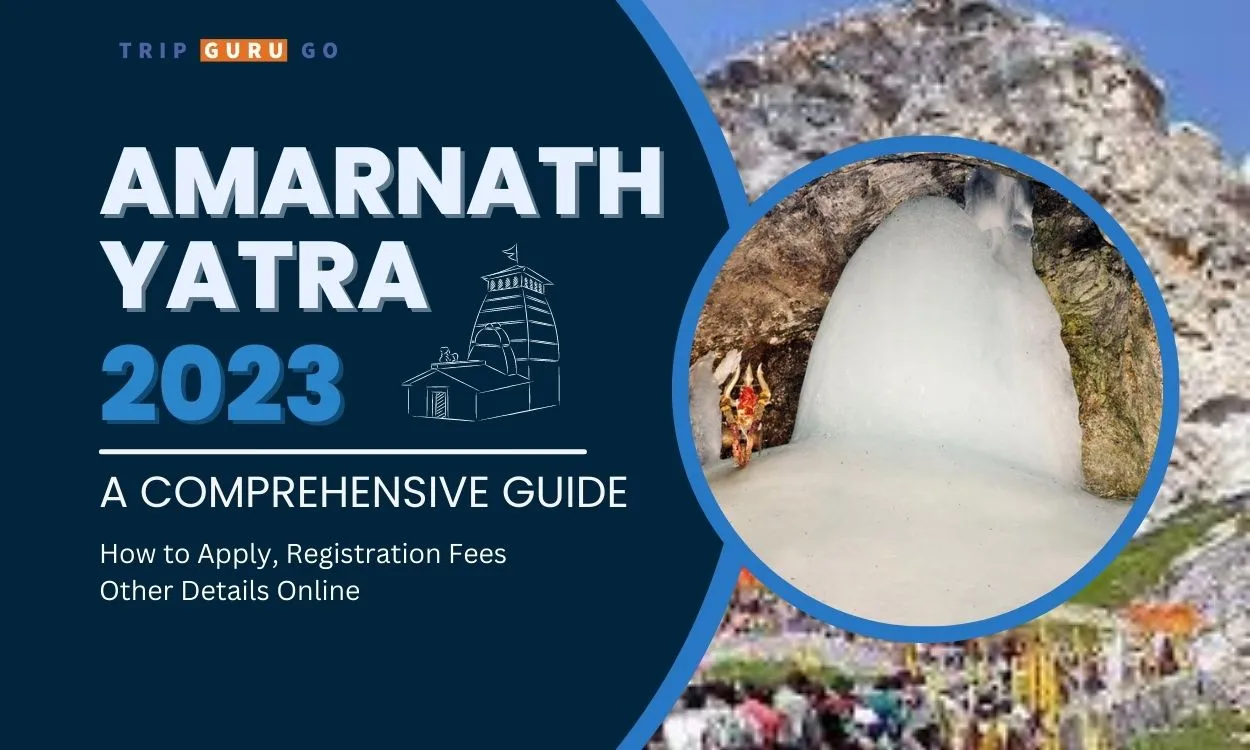Introduction to Amarnath Yatra
The Amarnath Yatra 2023 brings people from all over the world to the beautiful mountains of Jammu and Kashmir. That is a spiritual and very important journey. Hindu legend gives this yearly journey a lot of weight. The divine ice lingam is set up in the holy Amarnath cave, which you should visit. It’s a very moving time when the followers go there. It will last for 62 days, from July 1, 2023, to August 31, 2023, according to the Shri Amarnath Shrine Board. Followers of Hinduism think that this trip is important and that everyone should take it at least once. The goal of the trip is to see the Amarnath cave, a holy place for Hindus. Which is situated 3,888 meters above sea level in Srinagar. People believe that this cave is one of the most sacred places of Lord Shiva.
Brief Overview of the Amarnath Yatra Pilgrimage
Amarnath Yatra has been going on for hundreds of years. What a tough trip it is for tourists through snow-covered mountains and impossible Himalayan beauty. People undertake this arduous journey to pray to Lord Shiva and seek his blessings in the form of a sacred ice linga.
The yatra begins every year during the auspicious period of Shravan (July to August). In which thousands of pilgrims come out to see the ice Lingam. Which symbolizes eternity and the divine presence of Lord Shiva.
what is the history of Amarnath Cave?
The Amarnath Yatra is a religious journey to the Amarnath Cave. It is thought that a Muslim shepherd named Buta Malik found the cave in the 13th century and started the trek. According to a story, Lord Shiva blessed Malik with a bag of coal, which he later found to be a bag of gold when he got home. This cave is in the Pahalgam tehsil of the Anantnag district of Jammu and Kashmir, India. It is 3,888 meters above sea level. There are glaciers and snowy mountains all around it, and it snows most of the year. But travelers can visit for a short time in the summer. Indian Hindus see the cave as one of the holiest places to worship Lord Shiva and see it as an important temple.
what is the significance of Amarnath Cave?
For Hindus, Amarnath cave is a very important place and one of the most sacred temples of Lord Shiva. This cave is in Pahalgam tehsil of Anantnag district of Jammu and Kashmir, India. It is situated 3,888 meters above sea level. Glaciers and snowy mountains surround it, and it experiences snowfall for most of the year. But travelers can come here for a short period in summer. People believe that the ice shape in the cave looks like the Linga or Linga of Shiva.
Stalagmite formations inside a 40-metre (130 ft) high cave at an altitude of 3,888 meters (12,756 ft) on Mount Amarnath, which is 5,186 meters (17,014 ft). This is where the Lingam is found. Hindu mythology claims that the Amarnath cave was made when Lord Shiva’s third eye let out a ball of fire that hit a hill and cut it into a deep gorge. Many things make this cave important for Hindus. It is believed to be the place where Lord Shiva revealed the secret of life and eternity to Parvati. Secondly, there is a natural ice sculpture in the cave which is worshiped as the linga of Shiva. In Hinduism, people consider the Himalayas sacred mountains, and the cave is in the Himalayas.


Importance of the Amarnath Cave and the Ice Lingam
Amarnath Cave, which is situated about 3,888 meters above sea level. It is a very important place for people who believe in the Hindu faith. People think that the Ice Lingam, which changes size with the phases of the moon, is Lord Shiva’s eternal form. It is formed by the cave’s natural structure.
It is a wonderful phenomenon to witness the ice lingam. Which makes the visitors feel connected to God and their faith. Spiritual seekers see the trip to the holy cave as a metaphor for the hard times they have to go through on their way to knowledge and self-realization.
Duration of Amarnath Yatra
Beginning on July 1, 2023, and ending on August 31, 2023, the 62-day Amarnath Yatra is a journey. The walk can last anywhere from 36 to 48 km, based on how dedicated the traveler is. It takes three to five days to do the trip one way.
Planning for Amarnath Yatra 2023
To make sure the Amarnath Yatra 2023 is safe and rewarding, people must carefully plan their trip. Here are some important things you should do to get ready for this beautiful pilgrimage:
- Get Fit: Train for tough treks and high altitudes with regular exercise. Check your fitness with a doctor.
- Health Check: Get a thorough medical check-up. Carry meds and know altitude sickness prevention.
- Pack Smart: Travel light but for changing weather. Bring warm clothes, rain gear, sturdy shoes, and a first-aid kit. Sunscreen, hats, and sunglasses are a must.
- Stay Hydrated: Carry water and snacks. Eat nutritious meals for energy.
- Book Early: Secure accommodation in advance for a comfortable stay.
- Trek Training: If you’re new to trekking, practice before the Yatra for stamina and acclimatization.
Best Time to Visit Amarnath
The Amarnath Yatra takes place during the months of July and August, coinciding with the Hindu holy month of Shravan. These months offer favorable weather conditions with milder temperatures, making it the ideal time to embark on the pilgrimage.
| Ideal Yatra Time | Plan Wisely |
|---|---|
| July and August | During the Hindu month of Shravan. |
| Favorable, mild weather | Check official opening and closing dates. |
| Early July or August recommended | Avoid crowds for a peaceful pilgrimage. |
How to Reach Amarnath?
There are several ways to get to the base camps of Pahalgam and Baltal, from which the hike to the Amarnath Cave starts:
| Travel Option | Details |
|---|---|
| By Air | Srinagar International Airport is the nearest airport to the base camps. |
| Regular flights connect Srinagar to major Indian cities. | |
| Hire a taxi or opt for pre-arranged transportation to Pahalgam or Baltal from the airport. | |
| By Train | Jammu Tawi is the nearest major railway station, well-connected to various Indian cities. |
| Hire a taxi or take a bus from Jammu to reach Pahalgam or Baltal. | |
| By Road | The road network between Jammu and Srinagar is well-established. |
| There are regular bus services and private cars that go to Pahalgam and Baltal from both towns. |
Amarnath Yatra Registration: A Crucial Step
Getting registered for the Amarnath Yatra is an important and necessary step. The registration process helps the government to run the journey smoothly. This ensures that all visitors remain safe and healthy. Limiting the number of pedestrians at certain times and routes helps travel run more smoothly and has less impact on the environment.
During the registration process, you can also get useful information that can help you plan base camps and services along the way. It also lets officials help right away in an emergency. Making it an important step toward safer and more efficient travel. Please shorten it.
Amarnath Yatra Online Registration Process:
There is now an online registration method set up by the Amarnath Shrine Board to make the process easier. Here are the steps you need to take to finish the online registration process:
| Steps to Register for Amarnath Yatra | Details |
|---|---|
| 1. Visit the Official Website | Go to www.jksasb.nic.in, the official Amarnath Yatra website, to access the registration portal. |
| 2. Create an Account | Sign up if you’re a first-time pilgrim by providing basic info like name, contact, and email. |
| 3. Choose Yatra Date and Route | Log in and select your preferred Yatra date and route from the options available on the site. |
| 4. Complete Personal Details | Fill in your name, age, gender, address, and ID info, ensuring it matches your Yatra documents. |
| 5. Upload Required Documents | Scan and upload essential documents like a valid ID, photo, and medical certificate online. |
| 6. Make Payment Online | Pay the registration fee using credit/debit cards or net banking (fee varies for Indians/foreigners). |
| 7. Receive Confirmation | After successful payment, you’ll get a confirmation via email or SMS; keep it for Yatra reference. |
Documents Required for Registration Amarnath Yatra
To complete the Amarnath Yatra registration process, you need the following documents:
| Document | Description |
|---|---|
| Valid Photo ID | Government-issued ID (Aadhar card, passport, voter ID, or driving license) must be valid and not expired. |
| Recent Passport-sized Photograph | Clear and recent passport-sized photograph with a white background to be uploaded during registration. |
| Medical Fitness Certificate | Obtain a medical fitness certificate from a registered medical practitioner confirming your physical fitness. |
Amarnath Yatra 2023: Registration Fees, and Other Valuable Details
Amarnath Yatra 2023 Commencement and Duration
| Yatra Year | Starting Date | Last Date |
|---|---|---|
| 2023 | July 1, 2023 | August 31, 2023 |
Yatra Routes
| Route | District |
|---|---|
| Pahalgam track | Anantnag |
| Baltal | Ganderbal |
Amarnath Yatra Eligibility Criteria for Registration
| Age Range | Mandatory Health Certificate Required | Pregnant Women Eligibility |
|---|---|---|
| 13 to 70 years | Yes | Not allowed if ≥ 6 weeks |
Registration Fees for Amarnath Yatra
| Designated Banks | Registration Fee |
|---|---|
| Punjab National Bank, J&K Bank, Yes Bank, SBI | ₹120 per pilgrim |
| Online Registration Fee | ₹220 per pilgrim |
| NRI Pilgrims (PNB) | ₹1520 per pilgrim |
Application Process for Yatra Permit
| Documents Required | Permit Issuance |
|---|---|
| Compulsory Health Certificate (CHC), Fee Receipt | System-generated Yatra Permits (YPFs) |
| Route: BALTAL or PAHALGAM | Date for Access Control Gates Access |
Live Telecast and Essential Services
| Live Telecast Services | Amarnath Yatra App |
|---|---|
| Morning and Evening Aarti, Live Telecast Worldwide | Real-time Yatra Information, Weather, Online Services |
Security Measures
| Security Measures |
|---|
| Drones and Mine-Proof Vehicles for Safety |
Amarnath Yatra Routes and Trekking Options
Popular Routes to Reach the Amarnath Cave:
There are two famous routes for pilgrims to reach the holy Amarnath cave during Amarnath Yatra. The stunning beauty of the Himalayas Each path offers a different and unforgettable hiking experience:
- Pahalgam Route: Most people who do the Amarnath Yatra choose to go through Pahalgam, which is the usual way. It starts in the beautiful town of Pahalgam, which is known for its Lidder River and lush green fields. The hike is about 36 kilometers long and goes through beautiful slopes, thick woods, and the beautiful Sheshnag Lake. It is a wonderful trip through nature.
- Baltal Route: For walkers with more experience and people who like to try new things, the Baltal way is better because it is shorter but harder. The starting point for this trail is the base camp at Baltal, which is 14 kilometers from the Amarnath Cave. The trail is higher and rougher, but it gets visitors to the holy place faster, making it a great choice for people who don’t have much time.
Overview of Pahalgam and Baltal Routes
| Pahalgam Route | Baltal Route |
|---|---|
| Trek Distance: Approximately 36 km (one-way) | Trek Distance: Approximately 14 km (one-way) |
| Duration: Usually 3 to 5 days, depending on pace and acclimatization | Duration: Pilgrims can complete in 1 to 2 days, depending on fitness and acclimatization |
| Highlights: Picturesque landscapes, lush green meadows, Sheshnag Lake, Panchtarni campsite | Highlights: Steeper terrain, quick access to Amarnath Cave, snow-capped mountain views |
| Facilities: Better accommodation and food options, suitable for families | Facilities: Limited accommodation, suitable for experienced trekkers |
Difficulty Level and Best Practices for Trekking:
Difficulty Level:
On both ways, you have to hike at high elevations, but the levels of difficulty vary. Even though it’s longer, the Pahalgam path is easier because it goes up and down more gradually. But, the Baltal path is quicker but harder because it has steep climbs. Pilgrims need to be in good shape and ready for the difficulties that the rough terrain and high elevations bring.
Best Practices for Trekking:
- Acclimatization: Take enough breaks during the trek to acclimatize to the high altitudes. Avoid overexertion and stay hydrated to prevent altitude-related sickness.
- Proper Gear: Make sure you have the right outdoor gear because the weather can change quickly. Like strong, comfortable shoes, warm clothes, and rain gear.
- Team Spirit: Trek in groups or with a registered Yatra batch for safety and mutual support.
- Follow Guidelines: Follow the rules set by the Amarnath Shrine Board and other officials to have a safe and orderly Yatra.
- Environmental Consciousness: Respect the natural surroundings and refrain from littering. Carry a garbage bag to dispose of waste responsibly.
Choose the path that suits your needs and feels best. And follow best hiking practices. The sacred Amarnath cave is surrounded by the beautiful Himalayas, making a visit there unique and uplifting.
Amarnath Yatra Video 2023
Facilities and Accommodation
Tents, hotels, and other types of lodging are available at different places along the Yatra paths. It is advisable to book accommodations in advance to ensure a comfortable stay. To help the travelers, the government also set up medical care, food stands, and rest places.
Services Offered at the Base Camps
Pilgrims on the Amarnath Yatra can get the basic things they need at the base camps in Pahalgam and Baltal. These base camps are important resting places for hikers. They have many facilities to ensure that pilgrims are safe and comfortable:
- Restaurants and Food Stalls: Pilgrims can get hot meals and snacks at many restaurants and food stands at both base camps to get their energy back. To honor the holy nature of the Yatra, most of the food choices are vegetarian.
- Medical Centers: First aid stations and medical shops are set up in base camps to help with medical needs. So that people with minor accidents or health problems can get immediate help.
- Washrooms and Bathing Facilities: Clean bathrooms and bathing areas are available for the ease of pedestrians so that they can stay healthy.
- Security and Police Help: There are security guards and police posts at the base camps to make sure that the trekkers stay safe and healthy during their stay.
- Information Centers: Pilgrims can visit information centers. Which gives them current weather information, information about travel routes, and other useful data.
Tents, Guesthouses, and Other Accommodation Options
| Accommodation Type | Description |
|---|---|
| Tents | Set up by Yatra organizers and the Amarnath Shrine Board at base camps and along the route. Basic yet comfortable stay with separate arrangements for all genders. |
| Guesthouses and Dharamshalas | Available at base camps, providing more comfortable options. Limited availability; early booking recommended. |
| Private Accommodation | At the base camps, some private hotels and lodges offer extra warmth and services. |
Medical Facilities and Emergency Services Along Route
| Facility | Description |
|---|---|
| Mobile Medical Units | Along the way, there are medical aid stations with trained staff and medical materials for pilgrims. |
| Emergency Helpline | Dedicated number for emergency help in case of medical or unforeseen situations. |
| Ponies and Palanquins | Available for physically challenged pilgrims, accompanied by trained handlers for safety. |
| Air Evacuation | Arrangements for air evacuation in severe medical emergencies to nearby medical facilities. |
Pilgrims can focus on their spiritual journey without thinking about basic needs or safety. Because all these services are available at the place of residence. People visiting Amarnath Yatra can make the most of their visit by using these services and feel the divine energy of the holy Amarnath cave.
Amarnath Yatra Health and Safety Precautions
As part of the Amarnath Yatra, people walk at high altitudes, which can be hard on their bodies. Pilgrims who have health problems should talk to their doctors before going on the trip. Also, it’s a good idea to bring a simple first-aid kit in case you get hurt or sick.
Physical Fitness and Health Requirements for the Pilgrimage
If you want to do the Amarnath Yatra, you need to be in good shape because of the rough terrain and high mountains. Before you start this holy trip, you should think about the following health needs:
| Aspect | Details |
|---|---|
| Medical Check-up | Thorough medical examination and follow doctor’s advice. |
| Age Limit | Recommended for ages 13-75; not advised for under 13 or over 75. |
| Exercise Plan | Engage in regular exercise for stamina and endurance. |
| Chronic Conditions | Seek doctor’s approval for chronic health conditions. |
| Pregnant Women | Not advised for pregnant women over 6 weeks. |

High-Altitude Challenges and Acclimatization Tips
Going up to high elevations as part of the Amarnath Yatra can be hard on the body because there is less oxygen level there. To avoid getting altitude sickness, you must properly acclimate. Take a look at these suggestions:
- Gradual Ascent: Take the trek slowly, allowing your body time to adapt to the changing altitude. Avoid rushing and overexertion.
- Stay Hydrated: Drink plenty of water throughout the journey to stay hydrated. Dehydration exacerbates altitude-related issues.
- Rest and Acclimatize: Plan for acclimatization breaks at designated points during the trek. Spend time resting and relaxing to allow your body to adjust to the altitude.
- Avoid Alcohol and Smoking: During the Yatra, don’t drink booze or smoke because they can make it harder to get used to the altitude.
- Altitude Medication: If you have had problems with altitude sickness in the past, talk to your doctor about taking medicine for it.
Weather and Clothing
The weather in the Himalayas is hard to predict, and as you go higher, the temperature can drop by a lot. For the Yatra, it is important to bring warm clothes like jackets, gloves, and hats to protect yourself from the cold.
| Clothing for Yatra | Description |
|---|---|
| Warm Jackets | Essential to protect from cold at higher altitudes. |
| Gloves | Keep hands warm in unpredictable Himalayan weather. |
| Hats | Protect head from temperature drops as you ascend. |
Safety Measures During the Amarnath Yatra
During the Amarnath Yatra, safety should be the most important thing. Pilgrims should carefully follow what the authorities say. Traveling alone is not a good idea, and you should drink a lot of water. Also, it’s important to pay attention to how the weather changes and be ready for any situation.
To ensure a safe and secure pilgrimage, it is vital to adhere to the following safety guidelines:
| Guidelines | Tips for Safe Yatra |
|---|---|
| Stay on Designated Paths | Stick to established Yatra routes, and obey authorities. |
| Avoid Trekking at Night | Complete the trek in daylight for safety. |
| Weather Awareness | Be prepared for weather changes, and carry appropriate clothing. |
| Emergency Helpline | Save emergency numbers, inform family for quick assistance. |
| Environmental Responsibility | Respect the environment, avoid littering, and dispose properly. |
The Natural Formation of the Ice Lingam
The most mysterious and treasured thing about the Amarnath Cave is the holy Ice Lingam. People think that this stalagmite structure, which forms naturally inside the cave, shows Lord Shiva’s eternal form.
The ice lingam slowly comes to life every year as per the Hindu calendar. Shravan reaches its full form on the full moon day. As the moon goes through its phases, the penis gets bigger and smaller. Due to this the mystery of this divine event increases even more.
Watching the ice lingam in the Amarnath cave is a stunning experience for tourists. Making them feel awe and respect. It is a representation of how Lord Shiva is always present in his holy home in the Himalayas.
Rituals and Prayers Performed by Pilgrims
Amarnath Yatra is a spiritual journey undertaken by pilgrims with utmost devotion. This is not just a physical journey. As devotees reach the sacred cave, they engage in various religious practices:
| Experience | Description |
|---|---|
| Darshan (Divine Sight) | Pilgrims wait in line for hours to see the Ice Lingam, which is the most amazing part of the Yatra. |
| Pooja and Aarti (Rituals) | Priests and devotees perform worship and devotional songs at the Ice Lingam, fostering devotion. |
| Prayers and Chants | Chants of “Om Namah Shivaya” resonate in the cave as pilgrims seek blessings and spiritual insight. |
| Seeking Blessings | Priests bless pilgrims by giving them holy water and prasad, which means “blessed food.” |
The spiritual essence of the Amarnath cave and the sacred ice linga inspire pilgrims on a journey of self-discovery and devotion. Pilgrims believe Lord Shiva’s blessings here bring spiritual upliftment and liberation.
Local Culture and Cuisine
Immersing in the Rich Culture of Jammu and Kashmir:
Pilgrims can have a deep spiritual experience during the Amarnath Yatra. It is also a one-of-a-kind chance to learn about the rich and varied culture of Jammu and Kashmir. The culture of the area is a patchwork of different traditions, customs, and artistic forms that make the Yatra even more appealing.
| Experience | Description |
|---|---|
| Art and Handicrafts | Explore local markets for Kashmiri rugs, Pashmina blankets, copper utensils, and wooden paintings as souvenirs. |
| Folk Music and Dance | Enjoy vibrant folk music and traditional dance performances during the Yatra. |
| Local Festivals | Depending on the timing, witness local festivals in nearby villages, offering insights into regional culture. |
| Warm Hospitality | Interact with friendly locals to learn about their way of life and habits. |
Traditional Cuisines to Try During the Yatra:
The culinary delights of Jammu and Kashmir are as diverse as their cultural tapestry. During the Amarnath Yatra, pilgrims can savor a variety of traditional dishes that tantalize their taste buds:
- Kashmiri Wazwan: A traditional multi-course meal, Wazwan, is a must-try culinary experience. It has meals like Yakhni (a tasty yogurt-based lamb stew), Gushtaba (meatballs in yogurt gravy), and Rogan Josh (a hot lamb curry).
- Kashmiri Saag: Many people eat this filling food with rice or flatbread. It is made with leafy greens cooked with spices. It is a popular vegetarian option and is both nutritious and delicious.
- Kahwa: Kahwa is a traditional Kashmiri green tea that is made with saffron, cardamom, and cinnamon. It is a soothing drink that is also good for you.
- Phirni: Phirni is a delicious treat that ends a meal on a sweet note. It is a rice pudding flavored with saffron and topped with nuts.
Interacting with Local Communities and Fellow Pilgrims:
Through the Amarnath Yatra, people from all over the world can meet and share their stories. This mix of countries gives visitors a chance to meet and get to know other believers:
- Sharing Stories and Experiences: Talk to other travelers about their spiritual journey. The things they have seen and learned. Things they hope to achieve during the trip.
- Cultural Exchange: Interact with locals and learn about their customs, traditions, and daily lives. These interactions create moments of cultural exchange and mutual understanding.
- Volunteering and Community Service: Along the Yatra path, a lot of people do volunteer work for the community. Taking part in these kinds of events builds community and understanding among tourists.
- Collective Prayers: Join other tourists in group prayers and spiritual activities to create an atmosphere of peace and unity.
The Amarnath Yatra is more than a spiritual trip to the holy Amarnath Cave. It’s also a time to learn about and enjoy the local culture and food, as well as make links with other travelers and locals.
Do’s and Don’ts for Amarnath Yatra
There are some things that you should and shouldn’t do while on the Amarnath Yatra. Followers should keep the area clean, care for the earth, and be kind to other visitors. People must not leave trash in the Himalayas and hurt the fragile environment there.
| Do’s | Don’ts |
|---|---|
| Respect Local Customs and Traditions | Avoid Disrespectful Behavior or Attire |
| Follow Yatra Guidelines | Disregard Rules Set by Amarnath Shrine Board |
| Be Patient and Courteous | Show Impatience or Rudeness towards Others |
| Respect the Environment | Litter or Damage Natural Surroundings |
| Be Mindful When Taking Photographs | Take Photos without Permission |
| Carry Reusable Water Bottles | Use Single-Use Plastic Bottles |
| Dispose of Waste Responsibly | Leave Trash Along the Yatra Route |
| Respect Wildlife | Disturb or Feed Wildlife Along the Route |
| Use Eco-Friendly Toiletries | Choose Non-Eco-Friendly Toiletries |
| Stay on Designated Paths | Stray from Established Trekking Routes |
Respectful Behavior and Following Guidelines:
- Respect Local Customs: Embrace the local culture and traditions with respect and sensitivity. Avoid behavior or attire that may be considered disrespectful in the region.
- Follow Yatra Guidelines: Follow the rules set by the Amarnath Shrine Board and the officials to make sure your journey is safe and orderly.
- Be Patient and courteous. The Yatra can be crowded and challenging at times. Practice patience and courtesy towards fellow pilgrims and locals.
- Respect the Environment: Avoid littering and damaging natural surroundings. Leave the Yatra route and base camps cleaner than you found them.
- Photography: Be mindful when taking photographs. Seek permission before clicking pictures of individuals or sacred sites.
Amarnath Yatra Environmental Conservation and Responsible Tourism
- Carry Reusable Water Bottles: Minimize plastic waste by carrying a reusable water bottle and refilling it at designated points.
- Dispose of Waste Responsibly: Use designated waste disposal facilities. Carry a garbage bag to collect and dispose of trash properly.
- Respect Wildlife: Do not disturb or feed wildlife along the Yatra route. Maintain a safe distance and observe them from afar.
- Use Eco-Friendly Toiletries: Opt for eco-friendly toiletries to reduce environmental impact.
- Stay on Designated Paths: Stick to established trekking routes to avoid soil erosion and disturbance to the ecosystem.
Essential Items to Carry During the Amarnath Yatra Journey
| Essentials | What to Bring |
|---|---|
| Identity Documents | Valid photo ID (passport, voter ID) for registration and verification. |
| Medical Kit | Basic medical supplies (medications, bandages, antiseptic cream, etc.). |
| Warm Clothing | Jackets, gloves, thermal wear for unpredictable weather. |
| Rain Gear | Jackets, gloves, and thermal wear for unpredictable weather. |
| Comfortable Footwear | Sturdy trekking shoes with good grip for rugged terrain. |
| Flashlight | Flashlight or headlamp with extra batteries for night treks. |
| Cash and Cards | Sufficient cash and debit/credit card for emergencies and purchases. |
| Personal Medications | Adequate supply of medications if you have specific medical conditions. |
Contact Details and Helpline Numbers for Amarnath Yatra
| Contact Information | Details |
|---|---|
| Amarnath Shrine Board Website | https://www.jksasb.nic.in/ |
| Amarnath Shrine Board Email | sasbjk2001@gmail.com |
| Emergency Helpline Numbers | +91-191-2555662, 2503399 (November to April) Short Code 14464, Toll-free no.18001807198,18001807199 (May to October) |
| Police Control Room, Jammu | 100 |
| Police Control Room, Srinagar | 100 |
| Ambulance | 102 |
| Fire | 101 |
| Disaster Management | 1070 |
Pilgrims are advised to save these emergency numbers and carry a list of essential contacts during the Yatra.
Exploring Nearby Attractions of Amarnath Yatra
Pilgrims can enjoy the stunning views of Jammu and Kashmir after the Amarnath Yatra is over. Locations like Srinagar, Pahalgam, and Gulmarg offer stunning views and a chance to learn about the area’s rich cultural past. There are some other places also like:
- Martand Sun Temple: A religious site, currently open.
- Amarnath Cave: A prominent destination.
- Botanical Garden Kokernag: A beautiful garden.
- Amarnath Temple: Known for its caverns and religious significance.
- Mattan Temple: A religious site to explore.
- Surya Temple at Martand: Another religious site.
- Aishmuqam Shrine: A place of religious importance.
- Kherbawani Asthapan: Yet another religious site to visit.
Conclusion
The Amarnath Yatra is a spiritual and exciting trip that makes travelers feel humbled and blessed by God. Seeing the holy ice lingam in the Amarnath Cave is a deep and life-changing event. But it is very important to go on this Yatra with the greatest respect, care, and duty.
FAQs
Yes, the Amarnath Yatra is open to people of all religions who seek spiritual blessings and wish to experience the divine presence of Lord Shiva.
Children under the age of 13 and aged people individuals over 75 are not permitted to undertake the Yatra due to safety concerns.
Yes, the Amarnath Shrine Board has set age restrictions to ensure the safety and well-being of the pilgrims.
Photography is generally not allowed inside the cave, as it is considered a sacred space for prayer and meditation.
While hiring a guide is not mandatory, it can be helpful, especially for first-time visitors, to navigate the challenging terrain and understand the significance of the pilgrimage.
The Amarnath Yatra’s duration varies based on the route chosen: Pahalgam (4-5 days) or Baltal (2-3 days). Weather and physical fitness can also impact the Yatra’s duration.
The average cost of the Amarnath Yatra per person ranges from INR 15,000 to INR 30,000. Costs may vary based on the route, accommodation, and personal expenses.
The Amarnath Yatra is considered difficult due to its high altitude, challenging terrain, and unpredictable weather. Participants should be physically fit and prepared for the demanding journey.
The total distance of the Amarnath Yatra, considering both the uphill and downhill treks, is approximately 32 to 40 kilometers, depending on the chosen route.





